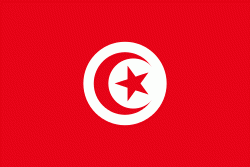Tunis Governorate (Gouvernorat de Tunis)
The Tunis Governorate is the largest industrial center in the country. Opening on the Mediterranean Sea, the governorate has a Mediterranean climate with annual rainfall reaching 470 mm. The area tapers towards the port and forms a narrow alluvial belt stretching westward, a distance of approximately 20 km2, taking in much farmland and two small freshwater lakes. The Medjerda River rising in Algeria has its much-diverted mouths in this area and its natural mouth would have discharged into the saltwater harbour around which neighbouring provinces have quarters of the central metropolitan area of Tunis. To the immediate south-west of the city centre is large freshwater lake, exceeding the size of the city centre fed by a distributive canal of the Medjerda. Its banks includes cultivated land to the west and the small Foret de Sijoumi to the east, with suburbs largely to the other sides. The urban area reaches over half of the length of the province. A very large market and hospitals area in the west of the capital is supplemented by wide roads and flyovers as well as three of the country's largest railway stations to make for a highly developed city centre in terms of trade and connectivity.
The area includes a container-handling port including large ferries to Salerno, Civitavecchia, Genoa, Palermo and Trapani in Italy and to Marseille in France. Its international airport and railway hub support its status as an established hub in hosting the government departments, stock exchange and major business headquarters of Tunisia. Culturally its national and international museum, the Bardo Museum hosts relics from each of the historic periods of western Mediterranean civilization and important works of art often in the manner of the classics or early Islamic tradition. This along with themed smaller museums and galleries, its mosques, souqs, traditional hotels, restaurants and nearby headlands, national parks and beaches make Tunis itself a major tourist destination.
Map - Tunis Governorate (Gouvernorat de Tunis)
Map
Country - Tunisia
 |
 |
| Flag of Tunisia | |
Beginning in early antiquity, Tunisia was inhabited by the indigenous Berbers. Phoenicians began to arrive in the 12th century BC, establishing several settlements, of which Carthage emerged as the most powerful by the 7th century BC. Carthage was a major mercantile empire and a military rival to the Roman Republic until 146 BC, when it was defeated by the Romans who occupied Tunisia for most of the next 800 years. The Romans introduced Christianity and left architectural legacies like the Amphitheatre of El Jem. In the 7th century AD, Arab Muslims conquered all of Tunisia (finally succeeding in 697 after several attempts starting in 647) and settled with their tribes and families, brought Islam and Arab culture to the local inhabitants, and since then Arabs became the majority of the population. Then, in 1546, the Ottoman Empire established control there, holding sway for over 300 years, until 1881, when the French conquered Tunisia. In 1956, Tunisia gained independence as the Tunisian Republic under the leadership of Habib Bourguiba with the help of activists such as Chedly Kallala, Farhat Hached and Salah Ben Youssef. Today, Tunisia's culture and identity are rooted in this centuries-long intersection of different cultures and ethnicities.
Currency / Language
| ISO | Currency | Symbol | Significant figures |
|---|---|---|---|
| TND | Tunisian dinar | دت | 3 |
| ISO | Language |
|---|---|
| AR | Arabic language |
| FR | French language |

















